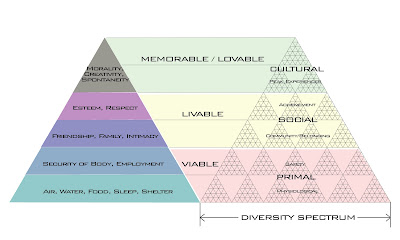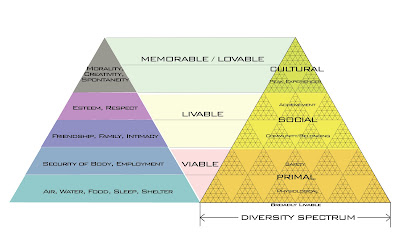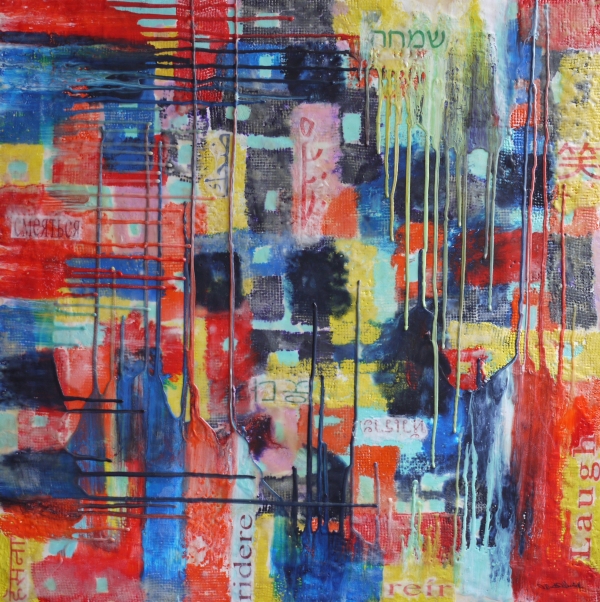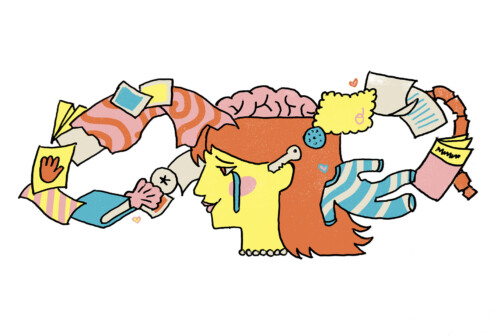
Painting by artist Heather Hennick.
I have often heard or read of planners suggesting that areas need diversity as if that quality is something you can will into existence with a magic wand, also known as the architect’s magic CAD station pencil. This is most often brought up in regards to revitalizing downtowns or other similar depressed areas. I have always found diversity as a goal for these places to be somewhat patronizing if not paternalistically liberal.
Is diversity absolutely necessary for creating livable places? The short answer is no.
In this post, I will show that diversity is more of a by-product of livability than it is a producer of livable places, which points to it as a very clear indicator of livability (an outcome). While there are certain design measures that can allow for diversity (accessibility, mobility, diversity of housing type), it cannot be willed into existence. However, it does contribute in other ways, which we will also examine.
Therefore, in areas in need of revitalization aka those in need of a greater degree of livability (or desirability), diversity can be a performance measure by which livability is measured. People often mistake revitalization for commerce. But commerce cannot exist sustainably and predictably without people, meaning livability. On the other hand, diversity is an absolute necessity for achieving higher levels of lovability or memorability as it comprises a broader base, the foundation authentic, upon which memorable places are built.
A biologist would say the greater amount of species in an ecosystem (diversity) the more complete the elaboration of life. In terms of cities, this means a broader base and the potential for a higher plane for what a City can be.
A rain forest (home to a greater array of kingdoms, phylums, families, orders, genuses, and speciese) serves as a natural metaphor as the most complete known elaboration of life. Not uncoincidentally, in many ways it provides life to everywhere else on the globe b/c it is such an exporter (resources, oxygen, co2 sink, etc.). A rain forest is the actualized city. These are the global cities bubbling over with culture and new ideas of thinking and being that are then exported to the rest of the world.
However, this also implies that life exists in lesser diverse situations, ie places deemed livable by various species. So how do we find that point and how does it apply closer to home? In Mercer’s recently released Global Livable Cities rankings, they aren’t ranking global “rain forests,” but places where the more basic needs of all are met the best.
Using Maslow’s hierarchy of needs as I am fond of, helps to determine exactly where and how a place might fit within the vague notion of livability. The pyramid is widest at its base where the most amount of people have those needs. We all need food, water, and air to survive. At the top, we don’t all need peak experiences of culture to survive. So livability isn’t about being “world class.” It is about other things.
Because livability is such an elusive concept and one that is difficult to define. The best way is to take the simplest, evidence-based approach. Are people living there? If not, why not? And because Livability can mean different things to different people, are different types of people living there?
Can an individual find a job and afford a residence nearby?
Are senior citizens able to get around? Do they have mobility?
Can children play in the streets or ride their bikes without the constant supervision of helicopter parents or be run over by maniacal valets?
Do women feel threatened or unsafe walking the streets alone or at night? Since women and children typically require a greater degree of safety than say me or Mac from Always Sunny in Philadelphia because we work our glamour muscles, can roundhouse kick and have made a collection of video tapes from Project Badass.

Totally.
If the answers to these and many other questions are yes, chances are diversity has been attracted for these various basic needs. Therefore the place is Viable, the foundation of Livability because all of the primal needs are met.
The next question to be asked and answered is what defines diversity? While diversity is often associated with race, it can mean a variety of age, gender, income, cultural heritage, background, etc.
As mentioned earlier, design can allow for certain amount of diversity but there are other mitigating factors at play beyond that of mere urban design. For example, nationality or race tend to congregate in areas for comfort, familiarity, or because of language barriers.
Uptown is a livable place, but is fairly narrow in its social makeup. This is reflected in its elaboration, particularly in its neighborhood services, the outgrowths of the residents. The commercial and social experience is similarly narrow, mostly alcohol induced at the many bars that while they may seem different are all as homogenous as its patrons.
However, uptown remains Livable because of its walkability and density. It achieves Social needs. This might be revealed in comparison to conventional drive-to suburban development where services are even more homogenous (greater reliance on chains).
Since only a certain segment of the population are able to satisfy their more basic needs in uptown, shelter and the affordability thereof as the predominant factor, uptown is only livable for a few and the foundation of the neighborhood is quite narrow (at least in its current iteration) and its potential limited.
This can also apply to downtown Dallas. While it is probably more affordable (now that rental prices in downtown are finding their right value), a greater array of income levels are able to live in downtown, but less people find it safe or appealing (for a variety of reasons). So the foundation remains narrower than it needs or should be in order to be as successful as we want.
However, I find it suitable to my needs. Even without a car, I have mobility due to adequate transit and a willingness to erode shoe leather. I can afford space that I like and have a number of bars and restaurants nearby. In my particular subjective criteria, I find it livable.
For example, give me an Indian buffet, a soul food joint, a good sushi house, and a neighborhood bar and I’m a happy man. The proprietors of those establishments should have the ability to be a part of the neighborhood as well if they so choose. But not only the proprietors, but the various generations of their families and their workers should be able to find suitable homes there as well. This further embeds their stake in and stewardship of the community while making it all the more authentic, which I define as unique qualities or character as a direct outgrowth of an area’s residents.
I once quipped that the only animals that existed in downtown Dallas were rats, carp, pigeons, and people. We’re in good company. That was of course, over 5 years ago and the population has since doubled. You can compare us newcomers to the grackles. To get to the next level, we need our neighborhoods (of which downtown is one) to be a better habitat for more species, more types of people. Whether the diversity follows is irrelevant to livability, but it isn’t to making Dallas a more memorable place and competing with the global “rain forests” of the world.
This City produces a preponderance of talent and homemade narcotics. But most of that talent leaves. I’m guessing it leaves because a lack of livability. As a City, we are in the global battle for talent together and our eventual success (or failure) is built on a foundation of livability.

If we want our city and our neighborhoods to be “rain forests” known and mentioned on the global scale, or to move up in the myriad of Livable Cities rankings sure to grow in number, we have to focus all areas on being livable for the greatest range of residents and do so with high quality, creative urban design. Who can then choose to live in the neighborhood that most suits the character for which they are looking. Where they can feel a sense of belonging.
This means ranges of housing types and affordability (shelter). It means access to transit and walkable neighborhoods (mobility). It means clean air, water, and I suppose I should say clean food. It means a free and fair political environment. It means safety through design (CPTED) and enforcement without sacrificing justice. It means fostering diversity and the opportunity for all to contribute what they have to offer the world through livability building a positive feedback loop where diversity uplifts livable systems (attracting diversity) into a more lovable, memorable City.






